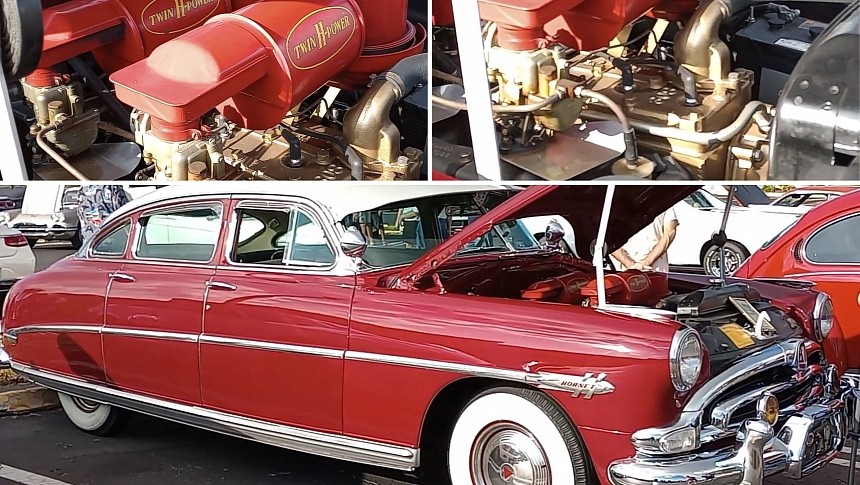Established in 1909, the Hudson Motor Car Company brought many innovations to the automobile market. It introduced dual brakes, the use of dashboard oil pressure, and generator warning lights, as well as the first balanced crankshaft. While it survived during the Great Depression, Hudson joined the list of independent automakers that went the way of the dodo bird in the 1950s.
Pressured by dwindling sales in a market dominated by Ford, General Motors, and Chrysler, Hudson merged with Nash-Kelvinator in 1954. The newly formed company, American Motors Corporation (AMC), became the fourth-largest carmaker in the United States. The Hudson brand soldiered on for three more years before AMC discontinued it in 1957.
Come 2023, most of the company's cars have been forgotten outside the Hudson fan club. Except for the Hornet, which lives on as proof that Hudson was more than an independent venture that couldn't keep up with the "Big Three."
Introduced in 1950, the Hornet was based on the company's innovative "step-down" design. First seen in the 1948 Commodore, it featured recessed floorplan footwells, which improved interior space, lowered the car's center of gravity, and allowed for more streamlined styling.
The Hornet's excellent handling and sleek design made it the perfect machine for NASCAR, winning three back-to-back championships from 1952 to 1954. All while using an inline-six engine instead of the V8 layout that had become popular at the time.
Despite its dominance on the NASCAR oval, the Hornet wasn't a high seller. The first generation moved some 131,600 units until 1954. AMC opted to keep the nameplate in production after the merger, but the "step-down" platform was dropped, and the Hornet was moved on Nash underpinnings.
Seven decades later and the first-gen Hornet is a relatively rare classic. The two-door coupes and convertibles are the most sought-after, but four-door sedans are also hard to come by, especially in unmolested or restored condition. The 1953 example you see here is part of the latter category, and it's one of the finest units I've seen in a very long time. And not only does it look outstanding inside and out, but it also packs an all-original (but refreshed) Twin H-Power mill under the hood.
Not familiar with the name? Well, it's a slightly beefed-up version of the 308-cubic-inch (5.0-liter) flathead inline-six that came standard across the Hudson lineup. Introduced as a dealer-installed option in mid-1951, it became a factory feature in 1952. Sporting twin one-barrel Carter carburetors with greater throat area and improved distribution, the Twin H-Power generated 145 horsepower and 275 pound-feet (373 Nm) of torque.
It may not sound like a lot, but remember that the Oldsmobile 88's "Rocket" V8 came with up to 160 horses on tap. Likewise, Cadillac's 331-cubic-inch (5.4-liter) V8 was also good for 160 horsepower, only marginally more than Hudson's big inline-six. And performance figures aside, the Twin H-Power is one hot-looking mill. Hit the play button below to check it out.
Come 2023, most of the company's cars have been forgotten outside the Hudson fan club. Except for the Hornet, which lives on as proof that Hudson was more than an independent venture that couldn't keep up with the "Big Three."
Introduced in 1950, the Hornet was based on the company's innovative "step-down" design. First seen in the 1948 Commodore, it featured recessed floorplan footwells, which improved interior space, lowered the car's center of gravity, and allowed for more streamlined styling.
The Hornet's excellent handling and sleek design made it the perfect machine for NASCAR, winning three back-to-back championships from 1952 to 1954. All while using an inline-six engine instead of the V8 layout that had become popular at the time.
Despite its dominance on the NASCAR oval, the Hornet wasn't a high seller. The first generation moved some 131,600 units until 1954. AMC opted to keep the nameplate in production after the merger, but the "step-down" platform was dropped, and the Hornet was moved on Nash underpinnings.
Seven decades later and the first-gen Hornet is a relatively rare classic. The two-door coupes and convertibles are the most sought-after, but four-door sedans are also hard to come by, especially in unmolested or restored condition. The 1953 example you see here is part of the latter category, and it's one of the finest units I've seen in a very long time. And not only does it look outstanding inside and out, but it also packs an all-original (but refreshed) Twin H-Power mill under the hood.
Not familiar with the name? Well, it's a slightly beefed-up version of the 308-cubic-inch (5.0-liter) flathead inline-six that came standard across the Hudson lineup. Introduced as a dealer-installed option in mid-1951, it became a factory feature in 1952. Sporting twin one-barrel Carter carburetors with greater throat area and improved distribution, the Twin H-Power generated 145 horsepower and 275 pound-feet (373 Nm) of torque.
It may not sound like a lot, but remember that the Oldsmobile 88's "Rocket" V8 came with up to 160 horses on tap. Likewise, Cadillac's 331-cubic-inch (5.4-liter) V8 was also good for 160 horsepower, only marginally more than Hudson's big inline-six. And performance figures aside, the Twin H-Power is one hot-looking mill. Hit the play button below to check it out.


